|
|
Kingdom |
Fungi |
|
Phylum |
Ascomycota |
|
Order |
Hypocreales |
|
Family |
Hypocreaceae |
Yield of storage roots was not affected in studies in the USA
using cultivars that varied from mild to severe symptom development. The
potential effect of CLD on quality of vines for use as food or feed has not been
reported.
The disease has been reported from Brazil, Kenya, Peru, and USA.
However, the causal fungus was isolated from botanical seed from a number of
additional countries. It appears that the disease is widely distributed and it
is likely that the disease occurs in many places from which it has not yet been
reported.
The youngest 2-3 leaves at the tips of vines become generally
chlorotic, sometimes becoming bright yellow, almost bleached in appearance . As
the leaves mature, they regain most of their normal colour. On cultivars that
normally have purple leaves, the leaves may become pink when affected with CLD. Following extended periods of conducive weather (sunny and humid),
marginal necrosis may develop on affected leaves (Fig. A). Mycelia of the causal
fungus may be seen growing out from between halves of leaves that have not yet
opened (Fig. B) or as scattered clumps on the upper surface of more mature
leaves (Fig. C). Associated with the mycelia may be phialides that produce
typical Fusarium macroconidia and microconidia. The latter clumps may appear
similar to salt deposits. On some cultivars affected leaves may be twisted or
distorted (Fig. D).
|
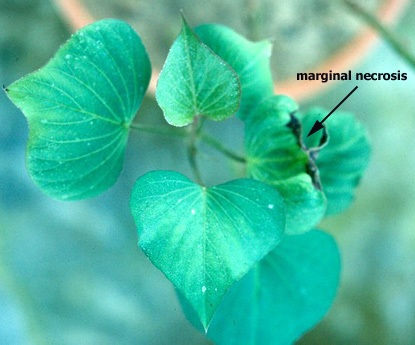
Fig. A
|

Fig. B
|
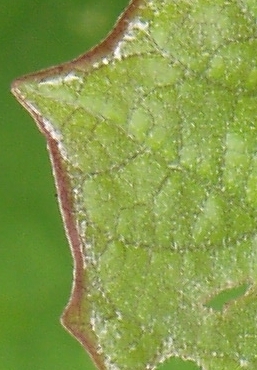
Fig. C
|
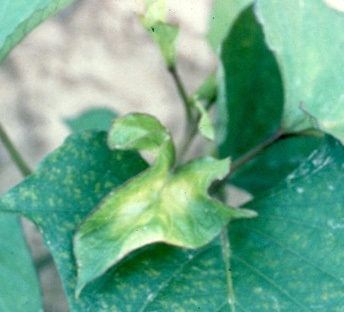
Fig. D
|
Polyphialides up to 20 μm long may be found in aerial mycelia
or on sporodochia. Conidia
are 0 to 5-septate with the 0-septate
averaging 2.5-3.5 x 7-10 μm and the 3-septate averaging 3.5-4.0 x 35-40
μm. Chlamydospores are not
produced.
The relationship between the causal fungus and plant host is
most unusual in that the fungus primarily colonizes the surfaces of the growing
vine tip without invading the plant. Mycelia are found on apical meristems and
between halves of developing leaves that have not yet opened. Once the leaves
open and expose the fungal mycelia, the mycelia appear to stop growing. As a
result, individual leaves appear to recover as they mature. Symptom development
is strongly favoured by warm, sunny, humid weather and
Chlorotic leaf distortion r. It is not known how the fungus overwinters
in temperate areas.
The disease is only known to occur on sweetpotato, although
other Convolvulaceous plants can be infected by artificial inoculation.
The unique symptoms and the presence of fungal mycelia and
characteristic Fusarium macroconidia are adequate for diagnosis.
Since CLD does not appear to affect storage root production,
management efforts have not been considered necessary. It is difficult to
eliminate the pathogen from planting material, but it has been successfully
eliminated by using the same meristem-tip culture techniques that are used for
virus elimination.
Clark, C. A. 1992. Histological evidence that Fusarium lateritium is
an exopathogen on sweetpotato with chlorotic leaf distortion. Phytopathology
82:656-663.
Clark, C. A., and Hoy, M. W. 1994. Isolation of Fusarium lateritium
from sweetpotato seed. Plant Dis. 78:585-587.
Clark, C. A., Valverde, R. A., Wilder-Ayers, J. A., and Nelson, P. E. 1990. Fusarium
lateritium, causal agent of sweetpotato chlorotic leaf distortion.
Phytopathology 80:741-744.
Icochea, T., Duarte, V., and Clark, C. A. 1994. Occurrence of sweetpotato
chlorotic leaf distortion in Brazil and Peru caused by Fusarium lateritium.
(Note) Plant Dis. 78:754.
Kihurani, A. W., Skoglund, L. G., and Gatumbi, R. W. 1993. Occurrence of
sweetpotato chlorotic leaf distortion caused by Fusarium lateritium in
Kenya. Plant Dis. 77:1260-1261.
Kim, B-K., La
Bonte, D. R., and Clark, C. A. 1996. Studies on sweetpotato with chlorotic leaf
distortion, caused by Fusarium lateritium. Internat. J. Pest Management
42:67-70.
Contributed
by: Christopher
Clark |
Taxonomy
Economic
importance
Geographical
distribution
Symptoms
Morphology
Biology
and ecology
Host
range
Diagnosis
Management
References
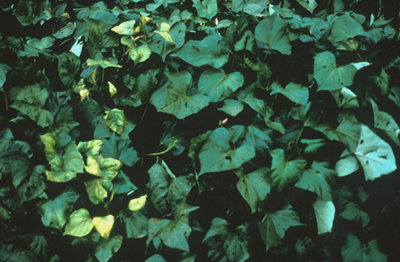
Youngest
leaves are generally chlorotic and may be distorted (C. Clark).

Youngest
leaves may have almost bleached appearance (C. Clark).
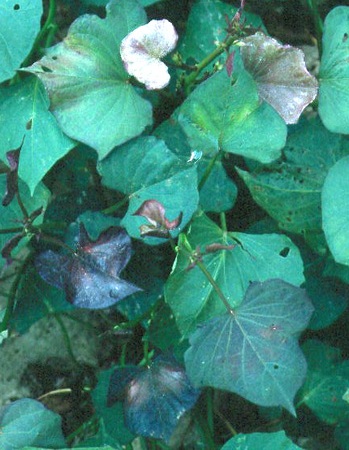
Pink appearance of affected young leaves on normally purple-tipped
genotype (C.Clark). |

